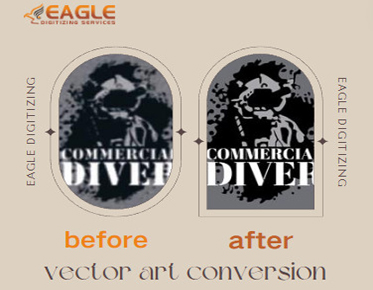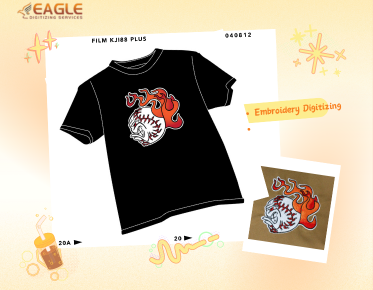Embroidery Digitizing Software for Small Biz vs. Hobby Fun
Embroidery digitizing is the process of converting designs into digital formats suitable for usage by embroidery machines. Whether you're a small business looking to produce custom apparel at scale or a hobbyist aiming to enhance your craft, choosing the right embroidery digitizing software is crucial. For small businesses, the software must handle high-volume production efficiently, offer advanced features, and integrate seamlessly with industrial machines. Hobbyists, on the other hand, may prioritize ease of use, creative freedom, and affordability. Understanding these distinct needs is the first step in selecting software that aligns with your goals.
Key Differences Between Business and Hobbyist Needs
Small businesses and hobbyists have different priorities when it comes to embroidery digitizing software. For businesses, features like bulk processing, automation, and integration with commercial embroidery machines are essential. These functionalities support high-volume production and streamline workflow. Hobbyists, however, often seek user-friendly interfaces, creative tools, and affordability. They may not require advanced automation but benefit from features that enhance design creativity and ease of use.
Why Choosing the Right Software Matters
Selecting the appropriate embroidery digitizing software can significantly impact your workflow and end-product quality. For businesses, the right software can lead to greater efficiency, reduced errors, and higher production volume. For hobbyists, it can enhance creativity, ease of design creation, and overall enjoyment of the craft. Investing in software that meets your specific needs ensures that you can achieve your desired results without unnecessary complications.
Budget Considerations: How Much Should You Spend?
Budget is a key factor in choosing embroidery digitizing software. For small businesses, investing in high-end software with comprehensive features might be necessary to handle large-scale production and complex designs. These programs often come with a higher price tag but offer robust capabilities and support. Hobbyists, however, may find that affordable or even free software options provide sufficient functionality for their needs. It’s important to evaluate what features are essential versus those that are nice to have to make an informed decision.
Business-Grade Software: Features Worth Paying For
For small businesses, investing in premium embroidery digitizing software can bring several advantages. Key features to look for include:
● Advanced Design Tools: Options for detailed editing, automatic stitch generation, and multi-color support.
● Bulk Processing: Ability to handle multiple designs simultaneously and automate repetitive tasks.
● Integration Capabilities: Seamless integration with various embroidery machines and other production tools.
● Technical Support: Access to professional customer support and regular software updates.
These features help ensure efficient production, high-quality output, and smooth integration with existing systems.
Hobbyist Software: Affordable Options Without Compromise
Hobbyists can find value in software that balances cost with functionality. Affordable options often include:
● User-Friendly Interfaces: Intuitive design tools that are easy to navigate.
● Creative Design Features: Tools for creating and customizing designs without requiring advanced technical skills.
● Basic Editing Capabilities: Essential features for resizing, repositioning, and modifying designs.
● Support and Resources: Access to tutorials and community forums for learning and troubleshooting.
While these programs may not offer the full suite of features found in business-grade software, they are well-suited for personal projects and smaller-scale designs.
Ease of Use: Navigating Complexities for Beginners vs. Pros
Ease of use varies greatly between software designed for professionals and that intended for hobbyists. Business-grade software often comes with a steeper learning curve due to its advanced features and capabilities. In contrast, hobbyist software typically prioritizes simplicity and ease of navigation, making it more accessible for beginners. It’s important to choose software that matches your skill level and comfort with technology to avoid frustration and maximize productivity.
Customization Capabilities: How Much Freedom Do You Need?
Customization is a key consideration in embroidery digitizing. For businesses, advanced customization options allow for the creation of intricate designs and variations. Features such as custom stitch types, detailed color management, and intricate pattern creation are essential for producing high-quality, unique products. Hobbyists, on the other hand, may focus more on creative freedom and the ability to experiment with different design elements. Software that offers a variety of design tools and flexibility can enhance the creative process and improve satisfaction.
Design Libraries: Stock Options vs. Custom Creations
Design libraries can be a valuable resource, providing access to pre-made designs that can be customized or used as-is. Business-grade software often includes extensive libraries with high-quality, professionally designed templates. This can save time and effort, especially when working with standard or repetitive designs. Hobbyists might also benefit from design libraries but may prioritize software that allows for more personalized, custom creations. The ability to import and manipulate custom designs is crucial for hobbyists looking to develop unique embroidery projects.
File Compatibility: Essential Formats for Businesses and Hobbyists
File compatibility is crucial for ensuring that designs can be seamlessly transferred between software and embroidery machines. Businesses typically require software that supports a wide range of file formats used in commercial embroidery, such as DST, PES, and EXP. This ensures that designs can be easily shared and used across different machines and platforms. Hobbyists should also consider file compatibility but may find that fewer formats are needed. Ensuring that the software supports common formats and offers import/export options can enhance convenience and flexibility.
Speed and Efficiency: Meeting Production Demands
For small businesses, speed and efficiency are critical. Business-grade embroidery digitizing software should provide fast processing times, efficient bulk handling, and streamlined workflows to meet production demands. Features such as batch processing, automated stitch generation, and quick design adjustments can significantly enhance productivity. Hobbyists may not have the same urgency for speed, but efficient software can still improve the design process and reduce waiting times.
Learning Curves: How Quickly Can You Master the Software?
The learning curve associated with embroidery digitizing software can vary widely. Business-grade software often comes with a more complex interface and advanced features, requiring a longer time to master. Comprehensive training and support resources can help mitigate this challenge. Hobbyist software typically focuses on ease of use, allowing users to quickly learn and start creating designs. Evaluating the learning curve and available resources can help ensure that the software aligns with your skill level and learning preferences.
Support and Resources: What’s Available for Users?
Support and resources play an important role in the user experience. Business-grade software usually offers extensive support options, including dedicated customer service, online tutorials, and community forums. These resources can help users troubleshoot issues and maximize the software's capabilities. Hobbyist software often provides support through online communities, FAQs, and basic tutorials. Access to helpful resources can enhance the overall experience and facilitate a smoother learning process.
Integration with Embroidery Machines: What to Look For
Seamless integration with embroidery machines is crucial for efficient design transfer and operation. Business-grade software should support a variety of machine brands and models, with direct communication and file transfer capabilities. Features such as machine compatibility settings and real-time previews can enhance integration. Hobbyists also benefit from compatibility but may focus on software that supports their specific machine and provides straightforward transfer options.
Advanced Features for Businesses: Automation and Bulk Processing
Advanced features such as automation and bulk processing are essential for businesses that handle large volumes of orders. Business-grade software often includes tools for automating repetitive tasks, processing multiple designs simultaneously, and managing large-scale projects. These features can significantly reduce manual effort, improve accuracy, and enhance overall efficiency. Hobbyists may not require these advanced functionalities but can still benefit from software that offers basic automation options for their projects.
Creative Freedom for Hobbyists: Exploring Artistic Options
Hobbyists often seek software that allows for creative exploration and artistic expression. Features such as customizable stitch patterns, design layering, and artistic effects enable users to experiment and create unique designs. Software that provides a wide range of creative tools and options can enhance the hobbyist experience and inspire new ideas. Balancing creative freedom with ease of use ensures that hobbyists can fully enjoy their embroidery projects.
Software Updates and Longevity: Staying Current
Software updates and longevity are important considerations for both businesses and hobbyists. Business-grade software should offer regular updates to address bugs, add new features, and ensure compatibility with evolving technology. Long-term support and ongoing development contribute to the software’s value and usefulness. Hobbyists also benefit from updates but may prioritize software that provides consistent performance and reliability over the long term.
Popular Embroidery Digitizing Software for Small Businesses
Several embroidery digitizing software options cater specifically to small businesses:
● Wilcom Embroidery Studio: Known for its advanced features and professional-grade capabilities, ideal for high-volume production.
● Brother PE-Design: Offers a range of tools for both design and machine compatibility, suitable for various business needs.
● Embird: Provides a comprehensive suite of features, including advanced editing tools and bulk processing options.
These programs are designed to handle the demands of business environments, offering efficiency, precision, and robust support.
Popular Embroidery Digitizing Software for Hobbyists
Hobbyists have access to several user-friendly and affordable embroidery digitizing software options:
● SewArt: Offers a range of design tools and an intuitive interface, suitable for beginners and experienced users alike.
● Ink/Stitch: A free, open-source option that provides essential digitizing tools and supports various file formats.
● Hatch Embroidery Software: Combines ease of use with powerful features, catering to both casual and more serious hobbyists.
These programs provide a balance of functionality and affordability, making them accessible to those pursuing embroidery as a hobby.
Comparing Costs: One-Time Purchases vs. Subscriptions
Embroidery digitizing software comes in different pricing models, including one-time purchases and subscription-based plans. One-time purchases offer the advantage of a single upfront cost, which can be preferable for those looking for long-term investments. Subscriptions, on the other hand, provide ongoing updates and support, which can be beneficial for staying current with software advancements. Evaluating the cost-effectiveness of each model about your needs and budget is essential for making an informed decision.
Challenges and Solutions: Common Issues in Embroidery Digitizing
Embroidery digitizing can present challenges, including:
● Complexity of Design: Managing intricate designs can be difficult, requiring careful planning and skillful use of software tools. Solution: Invest in software with robust editing capabilities and detailed tutorials.
● File Compatibility Issues: Ensuring that designs work across different machines and formats can be challenging. Solution: Choose software with broad file support and compatibility features.
● Learning Curve: Mastering advanced software can take time and effort. Solution: Utilize available training resources and start with user-friendly tools to build foundational skills.
Addressing these challenges effectively can lead to a smoother digitizing process and better results.
Selecting the right embroidery digitizing software is crucial for achieving success, whether you're running a small business or pursuing a hobby. Understanding the distinct needs of each user group, evaluating software features, and considering budget and support options are essential steps in making an informed choice. By choosing software that aligns with your goals and requirements, you can enhance your embroidery projects and achieve outstanding results.
.png)


